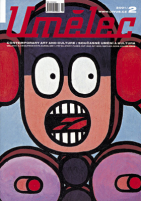| Umělec magazine 2001/2 >> Subtle Sci-Fi | List of all editions. | ||||||||||||
|
|||||||||||||
Subtle Sci-FiUmělec magazine 2001/201.02.2001 Lenka Lindaurová | review | en cs |
|||||||||||||
|
Marian Palla, Plzeň City Gallery, 12 April – 24 June 2001
Marian Palla’s exhibition in Plzeň was comprised of works from various periods of his career, as well as pieces he had specifically created for this exhibition. By distributing the work freely throughout the gallery’s basement halls he was able to put on a good presentation in this notoriously difficult space. The first image viewers encountered when entering the basement was one Palla “painted” (and signed) during the opening performance as a racy homage to Yves Klein’s Anthropometry. While Klein had beautiful women roll around in paint, here his successor imprinted his own belly button, ironically reflecting a self-centered character. He used a similar approach in an earlier work also displayed at this exhibition — a billboard reading: “I Want Money.” The central installation, Ten Thousand Nickels to Play With, continued to develop the money theme: It consisted of a “playground” made of coins and toys, an open and accurate symbol of our time. The exhibition contains many similar thematic interconnections. The belly button motif, for instance, leads us to the theme of alignment, one he has been preoccupied with for some time. Palla aligns objects like his belly button and the grass in a meadow, forming connections that are somewhat awkward. Conversely, he shrinks books like Art Today to fit the measurements of his own publications, which again represents the manifestation of himself. Such a reduction, however, could also be interpreted more profoundly as an expression of the principle of subjective reading, that is that we “truncate” everything to fit our own limited experience and understanding. Two Is More than One makes reference to Duchamp and Warhol, connecting homage with humorous distance. But the exhibition’s ubiquitous theme is that of children’s games and toys. Outlined shadows of a plastic duckling, a snorkel, and “something for the kids” look like humorous, pataphysical nonsense and at the same time are unnerving phantoms. Again referring to children’s games, Palla pinned a collection of dingy marbles made of mould in a show-case for butterflies. He also presented a monumental penis from the same material, which reflects the (over)production of artworks reflecting on pornography. Palla’s work is remarkably integrated, perhaps because it is comprised of very few components and the individual pieces only shift emphasis from one to another. They blend a racy humor, a critique of our time, Eastern metaphysics, and the rational reflection of Western modernism. Such a blend may not suit everybody, and it might be irritating in a different way from the one Palla intended. But on the Czech art scene, Palla is an interesting and precious phenomenon, perhaps an underestimated one too. That Palla’s exhibition took place in Plzeň City Gallery is especially significant considering the specific atmosphere of the city. Basically since the beginning of the 1980s, there have hardly been any personalities that have stood out on the gray local scene, except for Václav Malina and Milan Maur. In the 1980s, they drew energy for the exhausting battle with the local art establishment from active exchanges with artists in Prague and Brno, where their conceptual approach met with a great response. And in 1985, the two artists organized influential exhibitions at Brno’s Youth Gallery — so influential, in fact, that a letter of protest was sent to Brno by the former Artists Union, signed by the Communist chieftains and a painter who still heads the art department at the University of West Bohemia. Plzeň has not quite got over its stultifying past, but things seem to be improving a little, as witnessed by the fact that Václav Malina has taken on the unenviable position of the head of Plzeň City Gallery. Note, however, that he chose to exhibit artists from Brno. Photographs Jaroslav Vančát
01.02.2001
Recommended articles
|
|||||||||||||





Comments
There are currently no comments.Add new comment